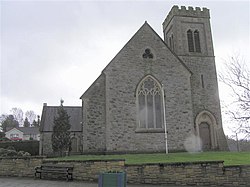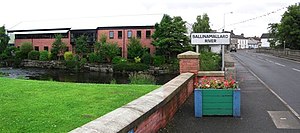Ballinamallard
| Ballinamallard Irish: Béal Átha na Mallacht | |
| Fermanagh | |
|---|---|
 The Methodist church | |
| Location | |
| Grid reference: | H260528 |
| Location: | 54°25’19"N, 7°35’42"W |
| Data | |
| Population: | 1,340 (2001) |
| Post town: | Enniskillen |
| Postcode: | BT94 |
| Local Government | |
| Parliamentary constituency: |
Fermanagh and South Tyrone |
Ballinamallard or Bellanamallard[1][2] is a small village and townland in the county of Fermanagh. It had a population of 1,340 people in the 2001 Census. It lies to the north of Enniskillen. The name is from the Irish Béal Átha na Mallacht meaning "ford-mouth of the curses".[3])
The village has won several "best kept village" titles, and has a fountain to mark the honour.
History
About AD 450 Magheracross said to have been founded by St Patrick and about 550 St Columba passed thorough Ballinamallard. The first records of the parish itself were in 1492 with Terence Macgillacossgli (Cosgrave) is recorded as vicar of Magheracross and Derrybrusk, Maghercross was at that time part of Derryvullen parish.
In 1500 two Maguire princes were ambushed by the O'Neills at Ballinamallard in their conflict and in 1539 the Original Magheracross church destroyed by fire.
1593 saw the start of Hugh O'Neill's war that resulted in the Flight of the Earls in 1611. Following which Henry Folliot of Pyrton in Wiltshire, was granted the Manor of Drumchine (later Newporton) including 1,500 Irish acres through Magheracross parish. He built Castle Murray and imported tenants from the area between Dumfries and Carlisle who were fleeing the union of England and Scotland and the consequent pacification of the previously lawless area around the border under James I that was taking place at that time.
By 1622 there were 20 houses in Ballinamallard and the Church "standing but not repaired within". In 1629 the old graveyard at Kilskeery and Magheracross was officially united with Kilskeery parish.
Religion was important through the 18th century. In 1704, Rev N Browne, Rector of Kilskeery, translated the Prayer Book into the Irish language. In 1766 Magheracross Parish split from Kilskeery and in 1769 John Wesley visited the area bringing Methodism. Coa Chapel was built in 1770. Ballinamallard Church was built in 1785 and the Methodist Hall was constructed in 1800. The Present Church of Ireland was built in 1844.
The 18th century also saw non-religious developments, Magheracross House was built in 1740 and the Ballinamallard bridge was built in 1750. 1783 saw the Repeal of Poyning's Law and the Birth of Orange Peggy.
In the early 20th century, thousands of Cooneyites or "Dippers", followers of Edward Cooney and William Irvine, flocked to religious conventions at Crocknacrieve House near Ballinamallard. Converts were baptised by immersing them in Lough Erne or tributary rivers, events which attracted large crowds and international attention.[4][5]
Economy
Many family businesses are located in Ballinamallard. In the 1970s the Development Association initiated some useful projects. The old Great Northern Railway station was restored to become the Rascal’s PlayStation, a purpose-built child care centre, while the Commons was transformed into a children’s playground and industrial units were established on the Enniskillen road.
Ballinamallard’s best known family are the Fishers, whose firm, Fisher Engineering, has brought substantial employment to the village. The company, which specialises in agricultural engineering and building construction, was founded by the late Thomas Fisher when he returned from World War II. Today Fishers are one of the foremost steel construction firms in the British Isles servicing such projects as the Waterfront Hall and the Odyssey Arena, both in Belfast.
Transport
Ballinamallard railway station opened on 19 August 1854, but was finally closed on 1 October 1957.[6]
Sport
- The village is the home of Ballinamallard United and Fermanagh Mallards F.C. Roy Carroll, a former Manchester United goalkeeper, used to play for Ballinamallard United.
- The area is particularly noted for its trout fishing, with Erne tributaries flowing through and around the village.
- Birthplace of Circuit of Ireland Rally driver Bertie Fisher.
People
- Rev. Brian Harper, Minister for the parish of Magheracross, Church of Ireland in Ballinamallard.
- Rev. James McDonald, a pioneer Methodist minister and contemporary of John Wesley was born in Ballinamallard. His three granddaughters became respectively: the mother of author Rudyard Kipling, the mother of Prime Minister Stanley Baldwin and the wife of artist Sir Edward Burne-Jones.[7]
- Sir Edward Poynter also had roots in the village.[8]
- His Grace The Most Rev. Dr Michael Jackson, the Church of Ireland Lord Archbishop of Dublin and Glendalough, lived in Ballinamallard in his youth. Archbishop Jackson previously served as Church of Ireland Lord Bishop of Clogher.
- In August 1998, Queen Elizabeth II was welcomed in Ballinamallard after visiting the site of the Omagh bombing, where she left her condolences. She returned in 2002 to open a foot bridge and nursery school as part of the Golden Jubilee celebrations.
Gallery
References
- ↑ Placenames NI
- ↑ Placenames Database of Ireland
- ↑ Flanagan, Deirdre & Laurence; Irish Place Names, page 172. Gill & Macmillan, 2002. ISBN 0-7171-3396-6
- ↑ "The Pilgrim Tramps. The Rite of Baptism. Immersion of 27 Followers in the Ballinamallard River" The Impartial Reporter and Farmers Journal, Enniskillin, Northern Ireland. 29 September 1904, p. 8.
- ↑ "Crowds Await Millennium. Cooneyites Hold Prayer Meetings and Baptize Hundreds Daily in Ireland" The New York Times, New York, New York. 4 August 1909, p. 3.
- ↑ "Ballinamallard station" (PDF). Railscot – Irish Railways. Archived from the original on 26 September 2007. http://web.archive.org/web/20070926042407/http://www.railscot.co.uk/Ireland/Irish_railways.pdf. Retrieved 2007-09-09.
- ↑ Sanderson, Ernest (1976). Discover Northern Ireland. Belfast: Northern Ireland Tourist Board. p. 142. ISBN 0 9500222 7 6.
- ↑ Flanders, Judith. 2001. A Circle of Sisters: Alice Kipling, Georgiana Burne-Jones, Agnes Poynter and Louisa Baldwin. New York: W. W. Norton & Company, p. 3. ISBN=0-393-05210-9
















